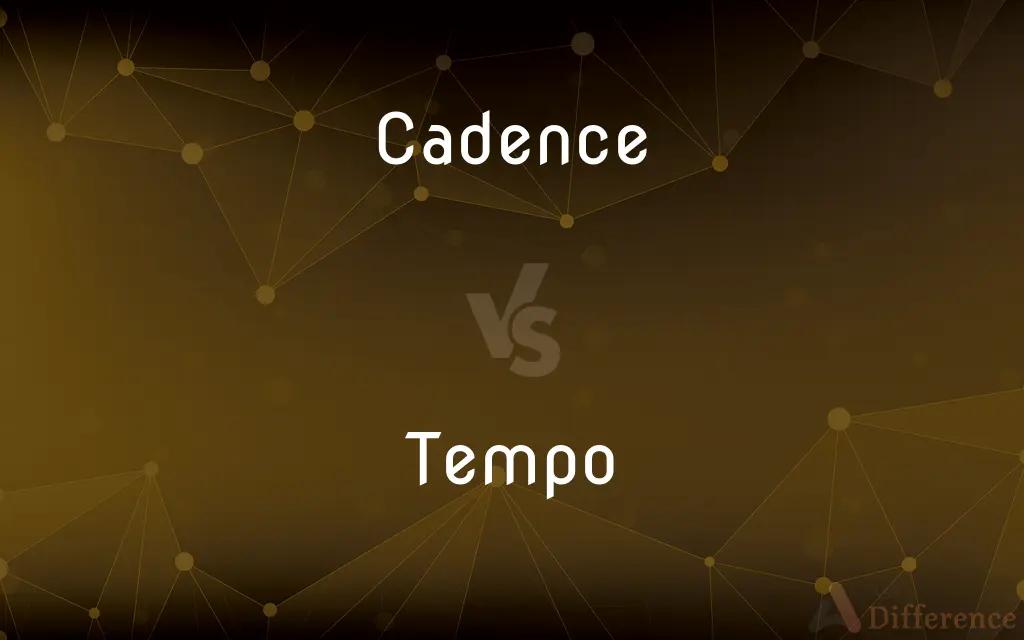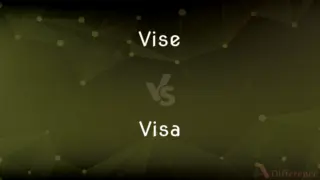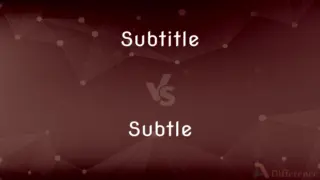Cadence vs. Tempo — What's the Difference?
Edited by Tayyaba Rehman — By Maham Liaqat — Updated on April 5, 2024
Cadence focuses on the rhythmic flow within music or speech, emphasizing patterns and pacing, while tempo specifies the speed at which music is played or a rhythm progresses.

Difference Between Cadence and Tempo
Table of Contents
ADVERTISEMENT
Key Differences
Cadence in music and speech relates to the rhythm and flow, creating patterns that give shape to the overall sound. It can vary within a piece to express different emotions or ideas. On the other hand, tempo is the consistent speed at which music or a rhythmic sequence progresses, measured in beats per minute (BPM), and sets the pace for the entire composition or segment.
While cadence deals with the concluding part of a phrase or sentence, providing a sense of closure or pause, tempo maintains the underlying beat that guides the pace of the musical piece or rhythmic pattern, regardless of the phrasing or sectional endings.
Cadence can be subtle or pronounced, affecting how a musical piece or spoken word ends or transitions between sections. Tempo, in contrast, remains steady and is a critical component for musicians and conductors to synchronize the performance of a piece.
In spoken language, cadence plays a vital role in conveying emotions, intentions, and nuances, adding depth to communication beyond the mere words spoken. Tempo, while less frequently applied to speech, can influence the perceived energy and urgency of the speaker's message.
Cadence and tempo together contribute significantly to the dynamics of musical and spoken expression. Cadence adds expressiveness and nuance, enhancing the emotional and structural aspects of music and speech, whereas tempo provides a foundation, setting the overall pace and energy level.
ADVERTISEMENT
Comparison Chart
Definition
The rhythmic flow within a piece, emphasizing patterns.
The speed at which a piece is played, measured in BPM.
Focus
Pattern and pacing within sections.
Overall speed of the piece or rhythm.
Measurement
Subjective, based on flow and feeling.
Objective, often measured in BPM.
Role in Music
Adds emotional depth and structure.
Sets the foundational pace and energy level.
Role in Speech
Influences emotion and nuance in communication.
Affects perceived energy and urgency of spoken message.
Compare with Definitions
Cadence
Affects how music or a segment concludes or transitions.
The cadence at the movement's end left the audience in anticipation.
Tempo
Sets the overall pace and energy of a composition.
The upbeat tempo of the song made it a hit on the dance floors.
Cadence
The rhythmic flow or pattern in music or speech.
The cadence of her speech captured the audience's attention.
Tempo
The speed at which a piece of music or rhythm is played.
The conductor increased the tempo, energizing the orchestra.
Cadence
Can change within a piece to convey different emotions.
The cadence slowed dramatically, mirroring the mood shift.
Tempo
Often measured in beats per minute (BPM).
They practiced the song at a tempo of 120 BPM.
Cadence
Marks the end of phrases or sections with a sense of closure.
The poem's cadence gave a soothing end to each stanza.
Tempo
Critical for musicians and conductors to synchronize performances.
Adjusting the tempo, the band matched their performance to the original recording.
Cadence
Adds depth and expressiveness to music and speech.
His storytelling was enhanced by the varied cadences of his voice.
Tempo
Remains constant throughout a piece, unless intentionally altered.
The steady tempo kept the dancers perfectly in sync.
Cadence
In Western musical theory, a cadence (Latin cadentia, "a falling") is the end of a phrase in which the melody or harmony creates a sense of resolution. A harmonic cadence is a progression of two or more chords that concludes a phrase, section, or piece of music.
Tempo
In musical terminology, tempo (Italian for "time"; plural tempos, or tempi from the Italian plural) is the speed or pace of a given piece. In classical music, tempo is typically indicated with an instruction at the start of a piece (often using conventional Italian terms) and is usually measured in beats per minute (or bpm).
Cadence
A modulation or inflection of the voice
The measured cadences that he employed in the Senate
Tempo
(Music) The speed at which music is or ought to be played, often indicated on written compositions by a descriptive or metronomic direction to the performer.
Cadence
A sequence of notes or chords comprising the close of a musical phrase
The final cadences of the Prelude
Tempo
A characteristic rate or rhythm of activity; a pace
"the tempo and the feeling of modern life" (Robert L. Heilbroner).
Cadence
Balanced, rhythmic flow, as of poetry or oratory.
Tempo
A frequency or rate.
10 calls per hour isn't a bad start, but we'll need to up the tempo if we want to reach our target of selling insurance policies.
Cadence
The measure or beat of movement, as in dancing or marching.
Tempo
(chess) A move which is part of one's own plan or strategy and forces, e.g. by means of a check or attacking a piece, the opponent to make a move which is not bad but of no use for him (the player gains a tempo, the opponent loses a tempo), or equivalently a player achieves the same result in fewer moves by one approach rather than another.
Cadence
A rhythmic chant, often in call-and-response form, used by soldiers to keep in step when marching or running.
Tempo
(bridge) The timing advantage of being on lead, thus being first to initiate a strategy to develop tricks for one's side.
Cadence
A falling inflection of the voice, as at the end of a sentence.
Tempo
The timing of a particular event – earlier or later than in an alternative situation (as in chess example)
Cadence
General inflection or modulation of the voice.
Tempo
(music) The number of beats per minute in a piece of music; also, an indicative term denoting approximate rate of speed in written music (examples: allegro, andante)
Cadence
(Music) A progression of chords moving to a harmonic close, point of rest, or sense of resolution.
Tempo
(cycling) The steady pace set by the frontmost riders.
Cadence
The act or state of declining or sinking.
Tempo
A small truck or cargo van with three or four wheels, commonly used for commercial transport and deliveries (particularly in Asian and African countries): a genericized trademark, originally associated with the manufacturer Vidal & Sohn Tempo-Werke GmbH.
Cadence
Balanced, rhythmic flow.
Tempo
(American football) A rapid rate of play by the offense resulting from reducing the amount of time which elapses after one play ends and the next starts.
Cadence
The measure or beat of movement.
Tempo
A temporary carport.
Cadence
The general inflection or modulation of the voice, or of any sound.
Tempo
The rate or degree of movement in time.
Cadence
(music) A progression of at least two chords which conclude a piece of music, section or musical phrases within it. Sometimes referred to analogously as musical punctuation.
Tempo
(music) the speed at which a composition is to be played
Cadence
(music) A cadenza, or closing embellishment; a pause before the end of a strain, which the performer may fill with a flight of fancy.
Tempo
The rate of some repeating event
Cadence
(speech) A fall in inflection of a speaker’s voice, such as at the end of a sentence.
Cadence
(dance) A dance move which ends a phrase.
The cadence in a galliard step refers to the final leap in a cinquepace sequence.
Cadence
(fencing) The rhythm and sequence of a series of actions.
Cadence
(running) The number of steps per minute.
Cadence
(cycling) The number of revolutions per minute of the cranks or pedals of a bicycle.
Cadence
(military) A chant that is sung by military personnel while running or marching; a jody call.
Cadence
(heraldry) cadency
Cadence
(horse-riding) Harmony and proportion of movement, as in a well-managed horse.
Cadence
(horseracing) The number of strides per second of a racehorse, measured when the same foot/hoof strikes the ground
Cadence
(software development) The frequency of regular product releases.
Cadence
To give a cadence to.
Cadence
To give structure to.
Cadence
The act or state of declining or sinking.
Now was the sun in western cadence low.
Cadence
A fall of the voice in reading or speaking, especially at the end of a sentence.
Cadence
A rhythmical modulation of the voice or of any sound; as, music of bells in cadence sweet.
Blustering winds, which all night longHad roused the sea, now with hoarse cadence lullSeafaring men o'erwatched.
The accents . . . were in passion's tenderest cadence.
Cadence
Rhythmical flow of language, in prose or verse.
Golden cadence of poesy.
If in any composition much attention was paid to the flow of the rhythm, it was said (at least in the 14th and 15th centuries) to be "prosed in faire cadence."
Cadence
See Cadency.
Cadence
Harmony and proportion in motions, as of a well-managed horse.
Cadence
A uniform time and place in marching.
Cadence
The close or fall of a strain; the point of rest, commonly reached by the immediate succession of the tonic to the dominant chord.
Cadence
To regulate by musical measure.
These parting numbers, cadenced by my grief.
Cadence
(prosody) the accent in a metrical foot of verse
Cadence
The close of a musical section
Cadence
A recurrent rhythmical series
Common Curiosities
What is tempo?
Tempo is the speed at which a piece of music or a rhythmical sequence is played, usually measured in beats per minute (BPM).
What is cadence?
Cadence refers to the rhythmic flow or pattern in music or speech, often marking the end of a phrase or section with closure.
Does cadence apply to spoken language?
Yes, cadence applies to spoken language, where it influences the emotional tone, clarity, and nuance of communication.
Why is tempo important in music?
Tempo is important because it establishes the speed and energy of a piece, influencing its mood and how it is perceived by listeners.
How does cadence affect music?
Cadence affects music by adding emotional depth and structural clarity, influencing how pieces conclude or transition between sections.
How does tempo influence a musical performance?
Tempo sets the overall pace and energy level of a performance, essential for synchronizing musicians and conveying the intended mood.
Can cadence change within a piece?
Yes, cadence can vary within a piece to convey different emotions or highlight shifts in thematic or narrative elements.
Is tempo the same as rhythm?
No, tempo refers to the speed of the music, while rhythm involves the pattern of sounds and silences within the music.
Can the tempo of a song change?
While the tempo of a song generally remains consistent, composers and performers can intentionally alter it for expressive purposes.
How do musicians keep track of tempo?
Musicians often use metronomes to keep track of tempo during practice, and rely on conductors or internal cues during performances.
How do composers choose the tempo for a piece?
Composers choose the tempo based on the emotional and expressive qualities they want to convey, as well as the technical demands of the piece.
How is tempo measured?
Tempo is measured in beats per minute (BPM), indicating how many beats occur in one minute.
Can tempo affect how we feel about a song?
Yes, the tempo of a song can significantly affect our emotional response to it, with faster tempos often associated with excitement and slower tempos with calmness.
What role does cadence play in communication?
Cadence plays a critical role in communication by affecting the rhythm, flow, and emotional impact of spoken words.
Is there a relationship between cadence and tempo?
Cadence and tempo are related in that they both contribute to the structure and expression of music and speech, with cadence focusing on rhythmic flow and tempo on speed.
Share Your Discovery

Previous Comparison
Vise vs. Visa
Next Comparison
Subtitle vs. SubtleAuthor Spotlight
Written by
Maham LiaqatEdited by
Tayyaba RehmanTayyaba Rehman is a distinguished writer, currently serving as a primary contributor to askdifference.com. As a researcher in semantics and etymology, Tayyaba's passion for the complexity of languages and their distinctions has found a perfect home on the platform. Tayyaba delves into the intricacies of language, distinguishing between commonly confused words and phrases, thereby providing clarity for readers worldwide.















































